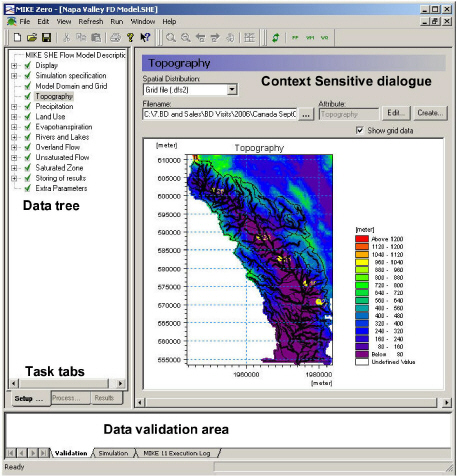
The Setup Editor

Figure 2.1 Graphical overview of the in the MIKE SHE GUI, without the Project Explorer.
The Setup editor is divided into three sections - the data tree, a context sensitive dialogue and a validation area.
The data tree is dynamic and changes with how you set up your model. It provides an overview of all of the relevant data in your model. The data tree is organized vertically, in the sense that if you work your way down the tree, by the time you come to the bottom you are ready to run your model.
The context sensitive dialogue on the right allows you to input the required data associated with your current location in the data tree. The dialogues vary with the type of data, which can be any combination of static and dynamic data, as well as spatial and non-spatial data. In the case of spatial and time varying data, the actual data is not input to the GUI. Rather, a file name must be specified and the link to the file is stored in the GUI. Furthermore, the distribution of the data in time and space need not correspond between the various entries. For example, rainfall data may be entered as hourly values and pumping rates as weekly values, while the model may be run with daily time steps.
The validation area at the bottom of the dialogue provides you with immediate feedback on the validity of the data that you have input.
After you have set up your model, you must switch to the Processed Data tab and run the pre-processing engine on the model. This step reconciles all of the various spatial and time series data and creates the actual data set that will be run by MIKE SHE. Once the data has been pre-processed the simulation can be started. Using the Pre-processing tab at the bottom, you can view the pre-processed data.
After the simulation is finished, you can switch to the Results tab, where you can view the detailed time series output as in a report-ready HTML view. Alternatively, you can use the Results Viewer, which is one of the generic MIKE Zero tools, for more customized and detailed analysis of the gridded output.